The Name Game: How Coral Naming Chaos Is Undermining the Hobby
Examining the culture of coral naming in the reef hobby

To understand the complex world of hobby naming conventions—with all its creativity, confusion, and controversy—we need to first trace its evolution from scientific foundations to today's marketing-driven approach. This history isn't just academic; it reveals how a practice that began with practical purpose has transformed into something that both energizes and frustrates the reef community.
By examining where we started and how we arrived at our current state of colorful chaos, we can better appreciate both the value of thoughtful naming and the problems created when naming conventions lose their moorings from the corals they're meant to identify.
The Scientific Foundation
Before Instagram-worthy coral names dominated frag swaps, reef keepers navigated the hobby using the scientific classification system developed by marine biologists. Corals were known by their genus and species—Acropora millepora, Montipora capricornis, Euphyllia ancora—creating a direct link to scientific research and reef ecology. Early hobbyists added simple descriptors such as "green" or "purple-tipped" to communicate variations, but the scientific foundation remained central.
As industry legend Michael Paletta recalls in his retrospective "The Coral Name Game," "In the early days of the hobby, when most of the corals were brown, many of us knew the genus and species of just about every coral we kept. Many of us could look in a tank and readily point out the Acropora valida from the Acropora nasuta." This taxonomic literacy wasn't just showing off—it created a universal language that transcended local markets and individual vendors.
The Birth of Trade Names
The shift toward named corals kicked off in the 1990s—earlier than many realize. In a revealing 2014 account on Reefs.com, Steve Tyree shared what might be the origin story of commercially named corals: the now-legendary "Purple Monster" Acropora (Lefevre, 2014). Tyree imported this distinctive coral from the Solomon Islands in 1995, when keeping Acropora in the US was still considered largely unfeasible.
Tyree began selling frags of this coral for $50 which at the time was a significant price for a frag. As he put it: "Listed PM frags for $50 to my email list and people started buying them... So the whole Limited Edition craze began." This major shift established that captive-grown coral fragments with distinctive names could command premium prices.
Around this same time, other pioneers developed their own naming approaches. Paletta notes in his 2016 Reefbuilders article, "One of the first people to start naming corals was the late Leroy Headlee. After Leroy grew these out, he sold frags of many of the colorful corals he got in, and in order to keep track of where they came from, he named them for their source."
These early naming conventions weren't marketing gimmicks—they served the practical purpose of tracking successful specimens and preserving their lineage. Names like "Paletta Blue Acropora" and "GARF Purple Bonsai" told you both what the coral looked like and where it came from. The "Oregon Tort" Acropora and the "Superman" Montipora (with its distinctive red and blue coloration) represented thoughtful naming that actually helped hobbyists.
Interestingly, Tyree himself never intended to create a brand: "And please note, I have never called my corals Tyree corals. Not once. Not ever. Everyone else did." The community itself drove the adoption of named corals, recognizing their value for identification and preservation.
The ORA Influence
While individual hobbyists pioneered coral naming, it was commercial coral farms like ORA (Oceans, Reefs & Aquariums) that truly standardized the practice. Starting in the early 2000s, ORA began assigning consistent names to their captive-bred corals, building a catalog of varieties with reliable characteristics.
Unlike the sometimes inconsistent naming by individual hobbyists, ORA's approach was methodical. Their names typically combined descriptive elements with a source identifier (e.g., "ORA Red Planet Acropora"), creating a system both memorable and informative. This commercial approach showed that standardized nomenclature could complement scientific classification while making coral identification more accessible to the average hobbyist.
“In the early days of the hobby, when most of the corals were brown, many of us knew the genus and species of just about every coral we kept. Many of us could look in a tank and readily point out the Acropora valida from the Acropora nasuta.
The Social Media Acceleration
The explosion of social media in the 2010s changed everything. Suddenly, eye-catching names became powerful marketing tools in an increasingly visual medium. Facebook groups, reef forums, and later Instagram transformed corals from living organisms into collectible status symbols that could be showcased instantly.
In a 2014 Reef Builders article "The Trouble with Coral Trade Names," a guest writer captured the growing tension perfectly: "As a seller, it is clear that named corals sell better than corals with a descriptive name such as 'red and blue' coral. Higher prices and greater overall demand are incentive enough for sellers to continue naming corals."
From Description to Fantasy
The real shift came when coral names disconnected entirely from descriptive elements. While early trade names typically combined color descriptions with source information ("Tyree Purple Monster"), newer names increasingly borrowed from pop culture, fantasy elements, and pure marketing psychology.
The Evolution of Coral Names
Names primarily described appearance with source attribution ("Palleta Blue Tip Acropora"), focusing on documenting lineage.
More creative but still somewhat descriptive naming emerged ("Fruit Loops Zoanthids," "Rainbow Millepora"), balancing marketability with useful information.
Fully fantasy/marketing names with little descriptive value took over ("Mystic Twilight," "Unicorn Blood," "Ultra Baby Yoda Acropora"), prioritizing attention-grabbing impact over information.
The Cultural Shift
A 2020 poll on Reef2Reef revealed this transformation has left the community divided, with 54% of respondents indicating that coral names are actually "getting in the way of enjoying the hobby." Having watched this evolution firsthand in my years working at a local fish store, I've seen both the appeal of creative names and the confusion they create.
My own "aha moment" about how chaotic naming had become arrived when I purchased a "zoanthid" called "Seduction." Later, I discovered this same coral was also being sold as TSA White Zombie, Agave, Salted Agave, Hawaiian Polyp, WWC White Zombie, Vivid Seduction—not to mention all the variations when labeled as zoa, paly, palythoa, zoanthid, or zoanthus. I've witnessed heated arguments at over whether a coral was one named variety or another based on barely perceptible differences in the red center coloration. What began as a system for tracking coral lineage had evolved into something resembling a hyper-commercialized - less creative - Pokémon collecting game.
Perhaps the most significant change wasn't just in naming convention but in the underlying purpose. As Michael Paletta notes, "Originally, names helped us track impressive specimens that needed to be preserved in the hobby through propagation. Today, names are often created before a coral has proven itself worthy of distinction."
This shift reflects broader changes in the reef hobby itself—from a community focused on husbandry and preservation to one increasingly influenced by collecting and commerce. As one forum member poignantly observed, "It's like designer dog breeds of the coral world."
The Balance Sheet: Benefits and Challenges of Coral Naming
The evolution of coral naming from scientific classification to creative marketing has produced a complex set of trade-offs that affect everyone in the hobby—from beginners to experts, from casual hobbyists to professional vendors. Let's examine both sides of this balance sheet.
When Names Fail Their Purpose
The fundamental purpose of any naming system is identification—a way to recognize and differentiate organisms. Yet today's naming landscape often undermines this core function in several critical ways.
Recognition Impossible and Price Without Logic
To understand the scope of the problem, we analyzed our CoralDB dataset of over 12,000 coral listings and discovered some insightful data on naming conventions:
Price Variations
Zoanthids and Euphyllia show the most extreme naming inconsistency. Our analysis of "Rasta Zoa" found the exact same coral being sold by 7 different vendors at prices ranging from $20 to $75 — a massive difference for identical genetic material with the same trade name.
Premium Pricing
Named varieties command a significant price premium over similar generic corals, suggesting strong consumer psychology effects. Named varieties also have an average demand index of 73.9, while generic descriptors average only 66.5.
Vendor Divide
Named varieties like "Walt Disney" Acropora are sold by only about a fifth of vendors, suggesting specialty stores focus on named corals, while mainstream stores generally stick to generic descriptors, and that most naming trends are driven by a minority of the vendors.
While these insights are revealing, the best way to understand how wild both naming and pricing of named varieties has become is to see for yourself.
The Same Coral, Many Names: A Visual Comparison
Want to see just how chaotic coral naming and pricing has become? I conducted a market survey of Euphyllia torch corals—the hobby's most popular and often most expensive LPS corals. The results are eye-opening. The screenshots below are paired strategically to illustrate two key problems in the market: 1. Nearly identical corals sold under different names with dramatically different prices 2. Completely different coral varieties sharing the same name and priced inconsistently You'll see price variations of up to 400% for what appears to be genetically identical coral material, with differences seemingly based on naming conventions and marketing approaches alone. A standard torch coral transforms into a "Holy Grail" at $899, gains a vendor prefix and jumps to $1,200, or paradoxically shifts from a "Banana Grail" to a "Super Rare Banana Grail" with a $300 price decrease. What makes this particularly notable is that our CoralDB analytics confirm Euphyllia dominates the market—it's the single most commonly sold coral genus, with gold being the most prevalent color variant (though closely followed by green). This can be pinned on many statistical factors the biggest of course being demand but also these corals are being aquacultured and maricultured at an astonishing rate, yet creative naming is a factor aiding certain price points to remain elevated despite increasing availability. Notice how many of these listings display "sale" prices—potentially signaling that the market is beginning to self-correct as supply increases and consumers become more discerning.
As you browse through these paired examples, look beyond just the individual comparisons. Notice how some corals share identical names but look completely different, while others appear virtually identical but carry vastly different price tags. Ask yourself: Is there legitimate justification for these price discrepancies? What real value do these naming conventions provide to the hobby, and whom do they ultimately serve?
.png&w=3840&q=75)
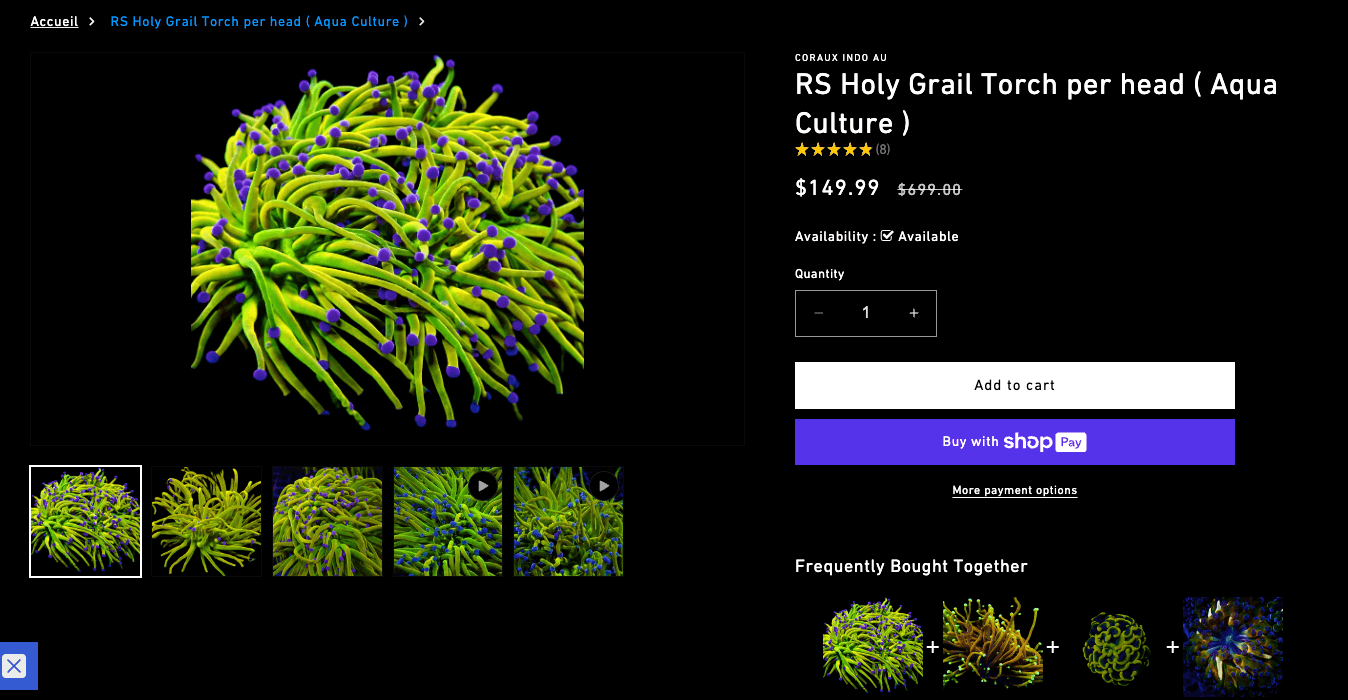
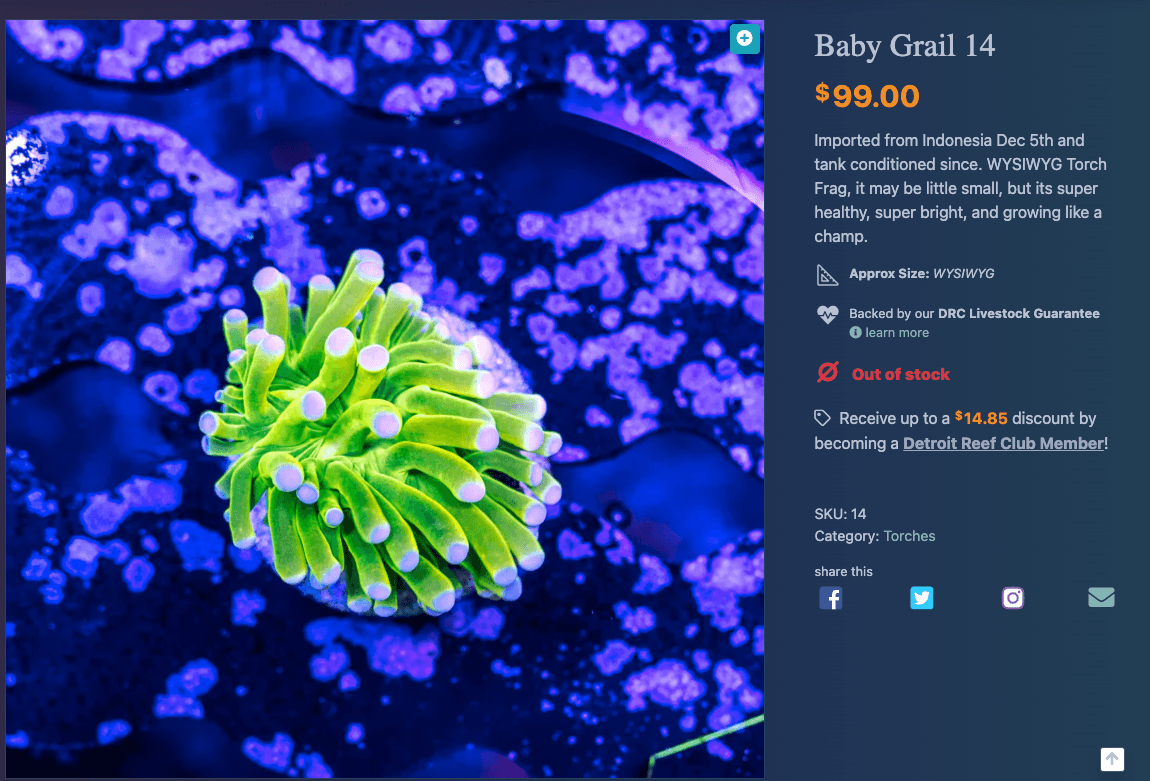
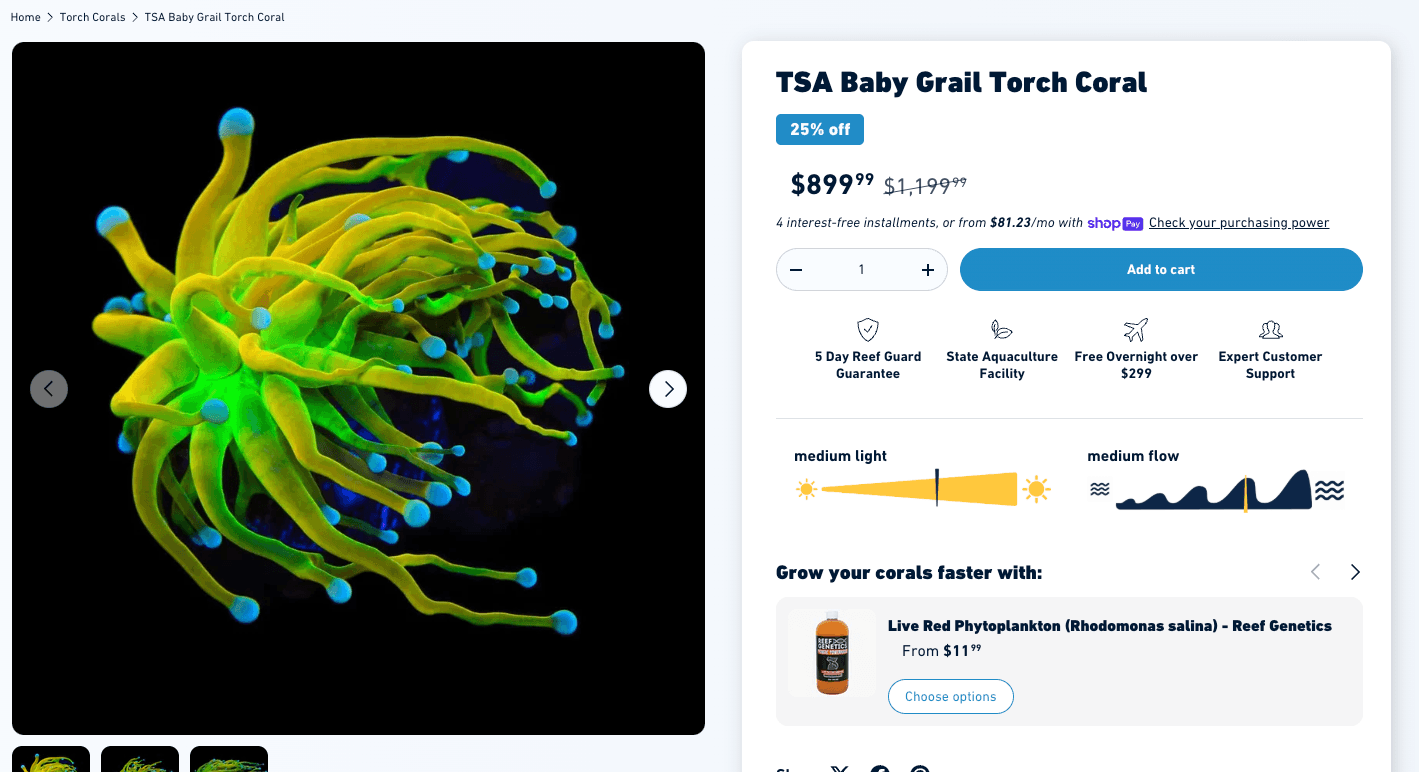
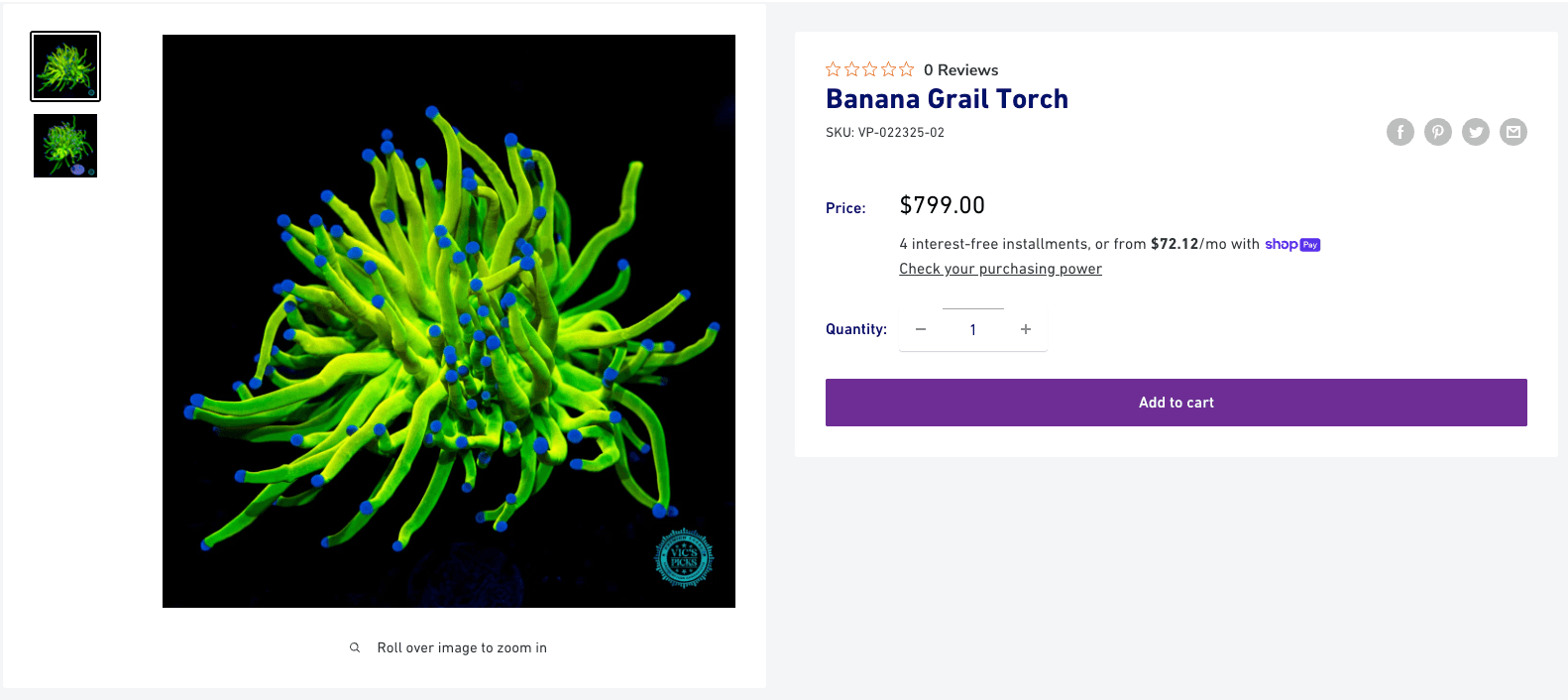
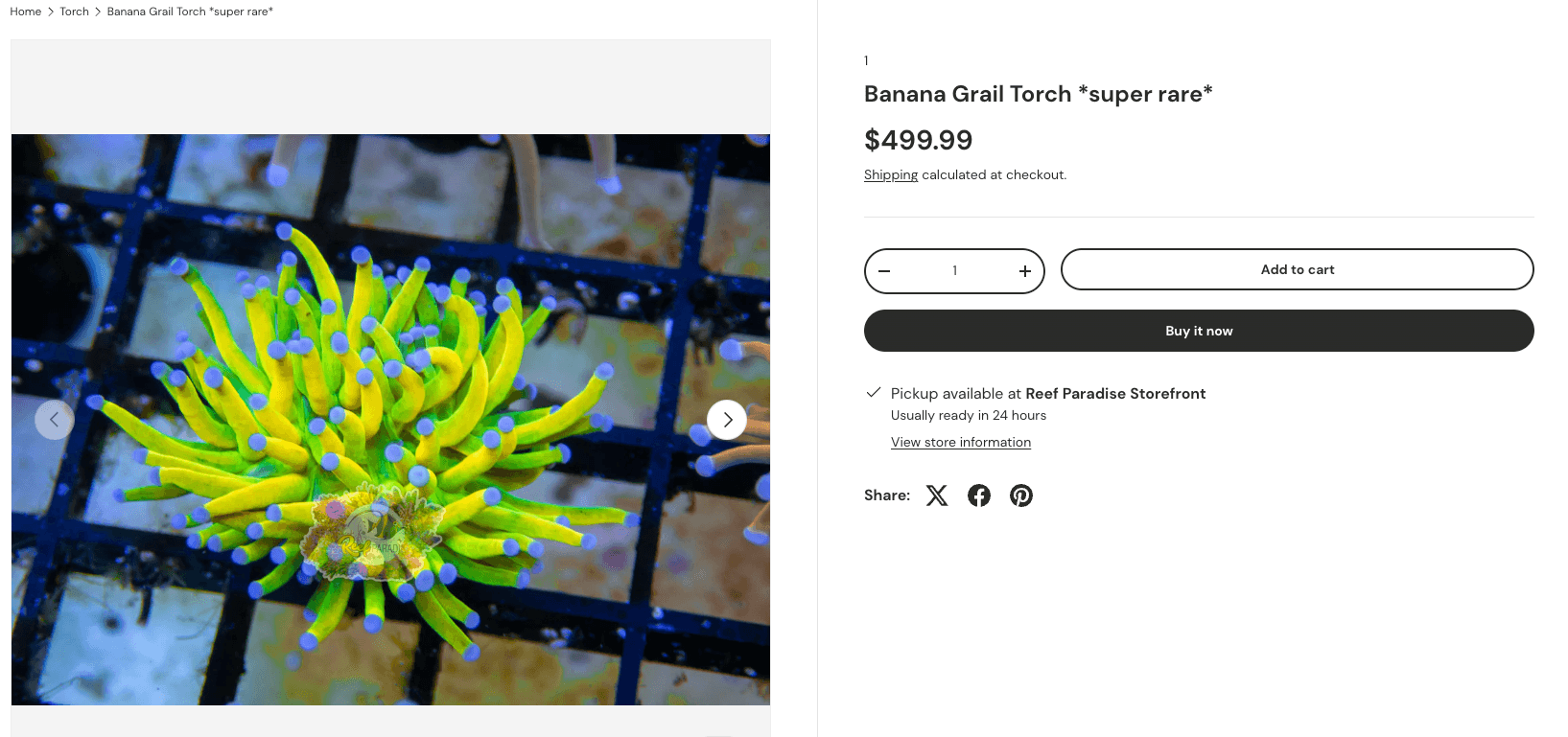
.png&w=3840&q=75)
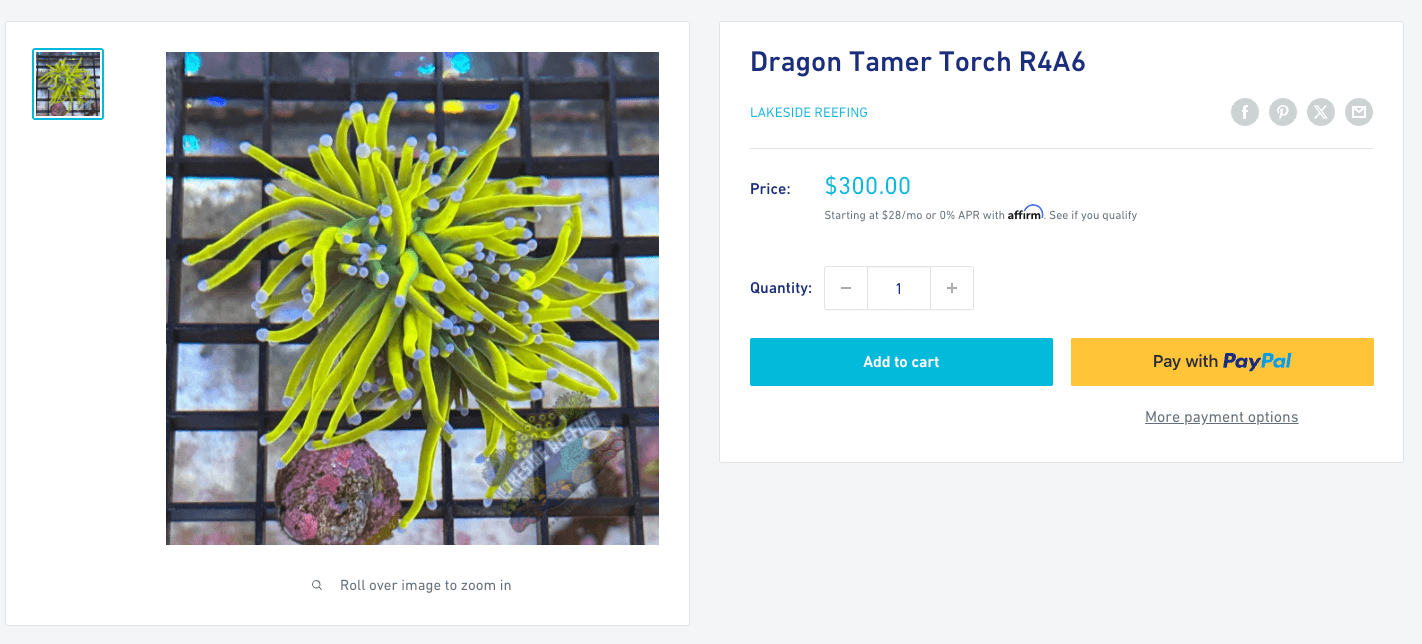
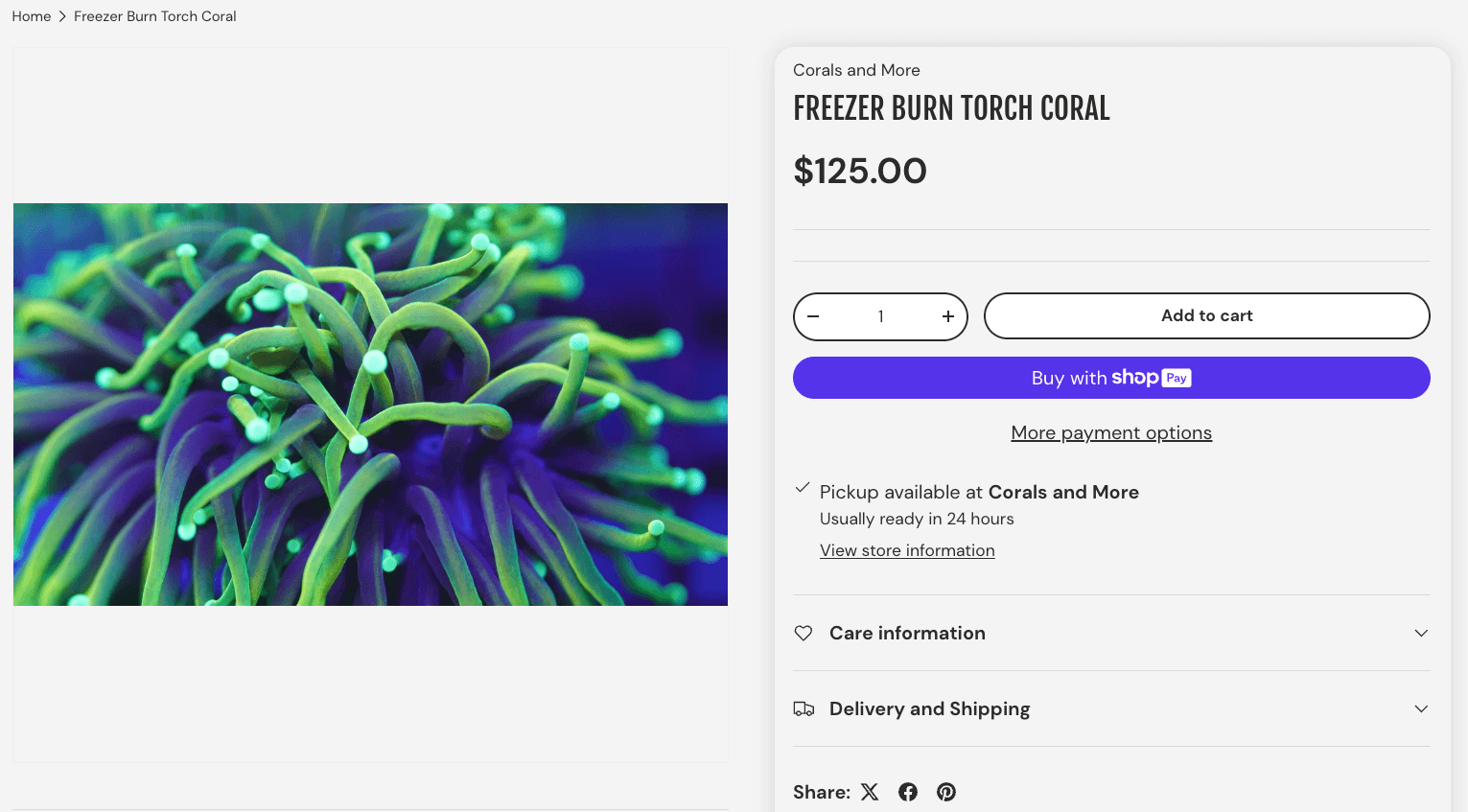
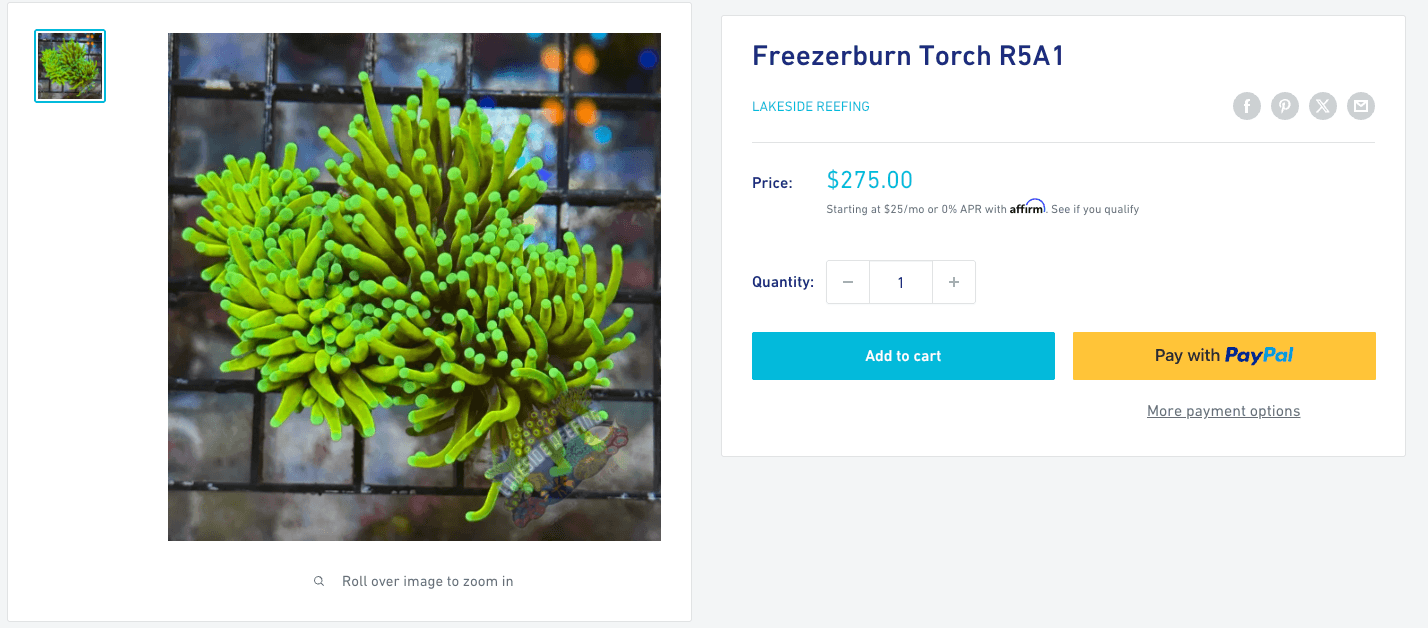
.png&w=3840&q=75)
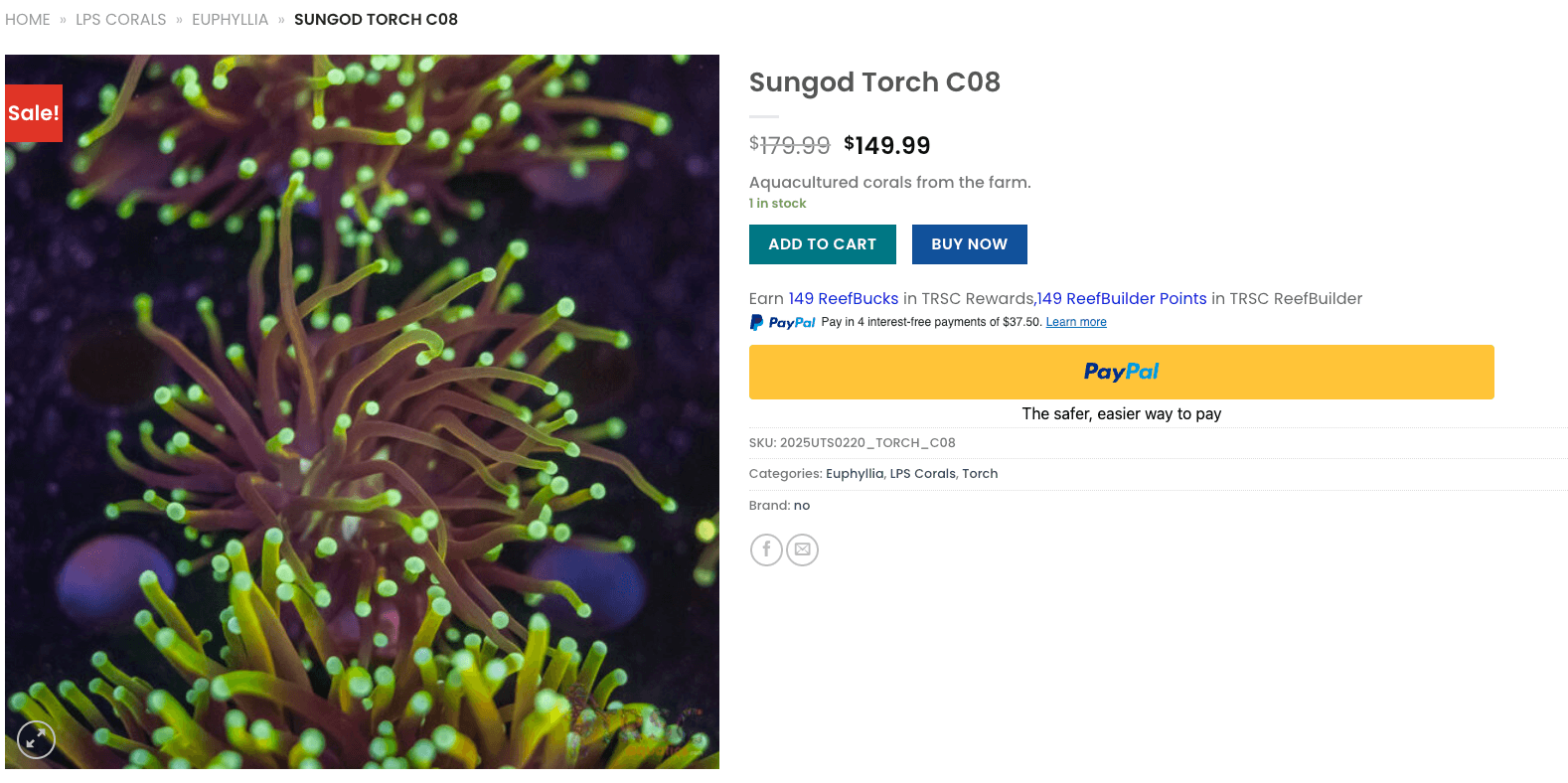
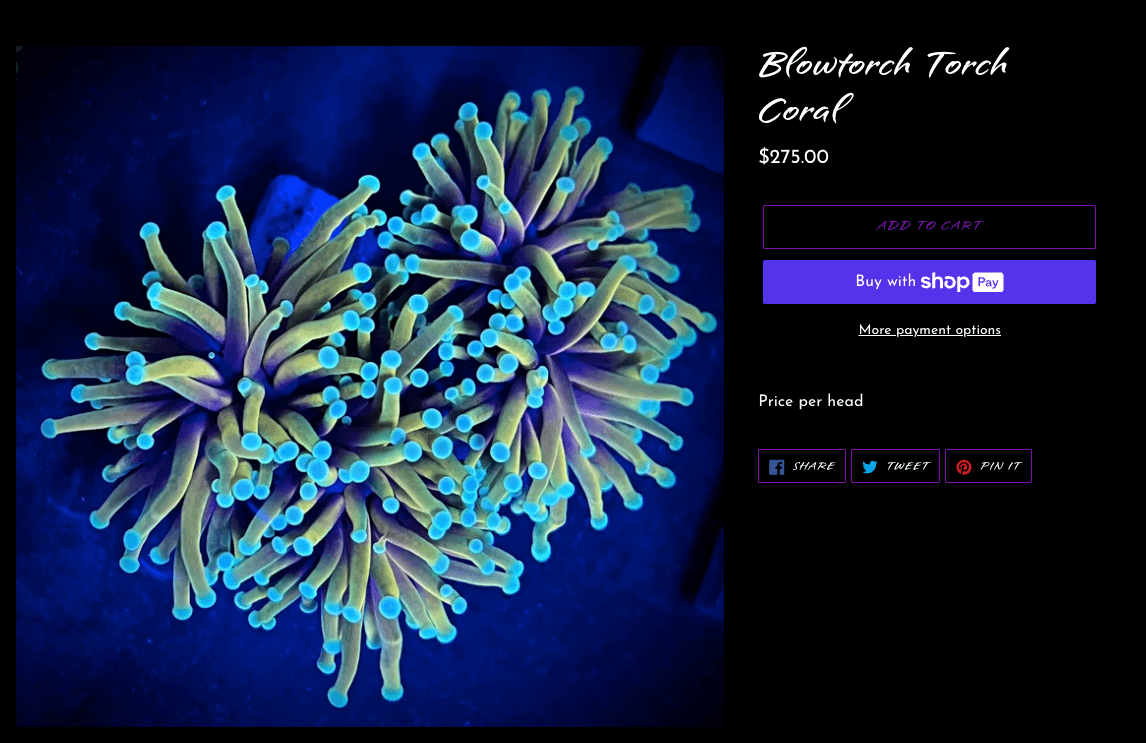
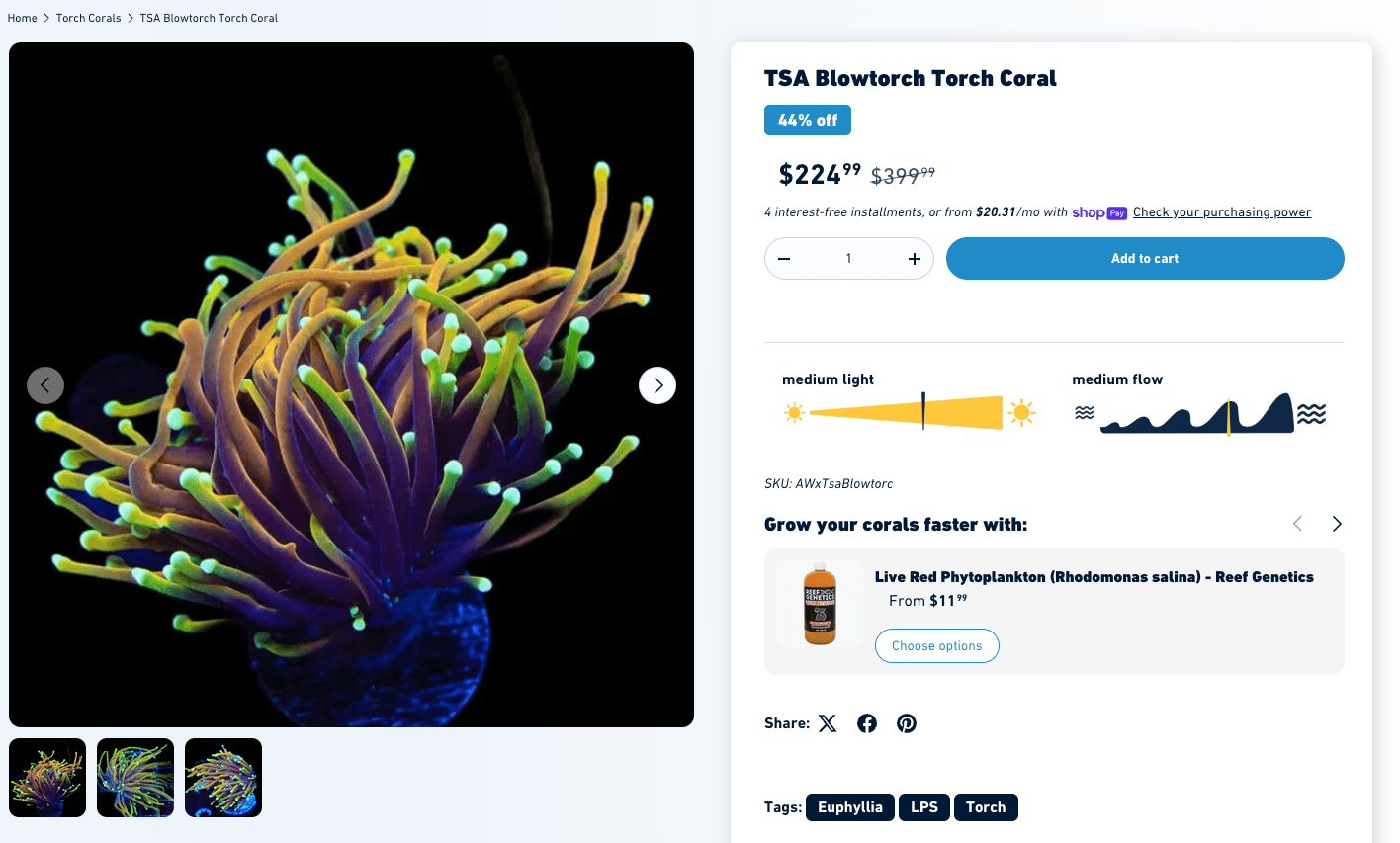
.png&w=3840&q=75)
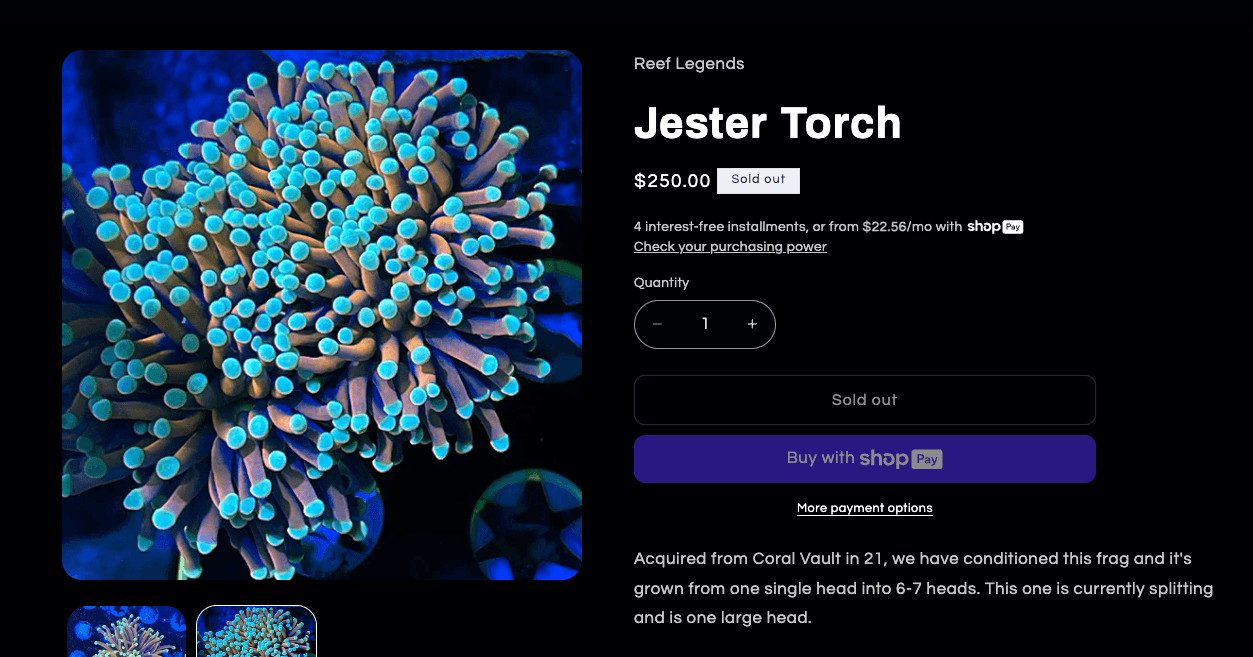
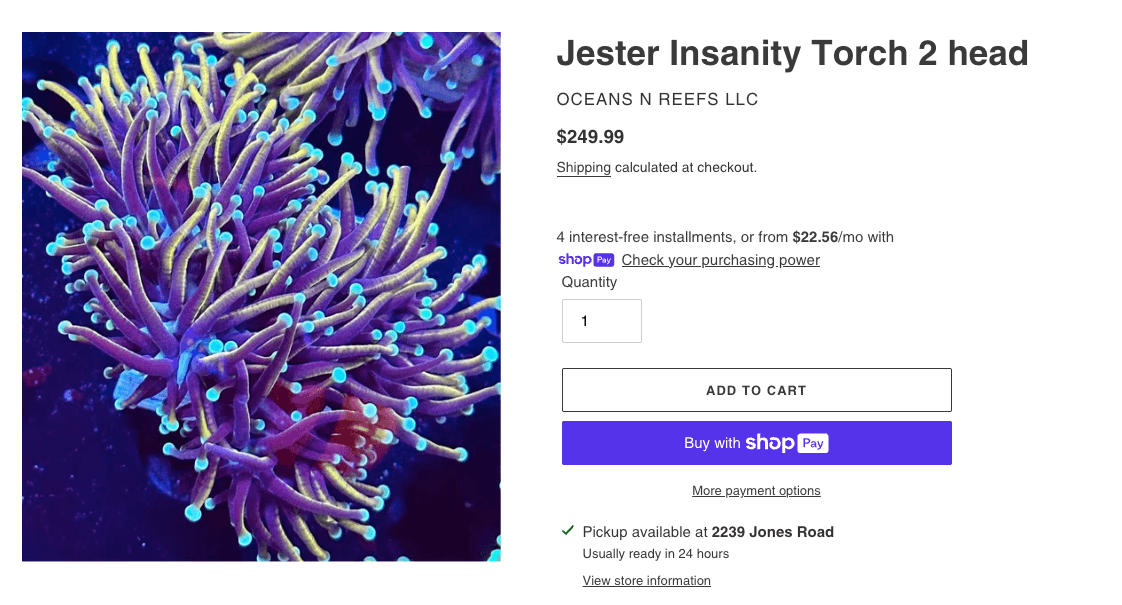
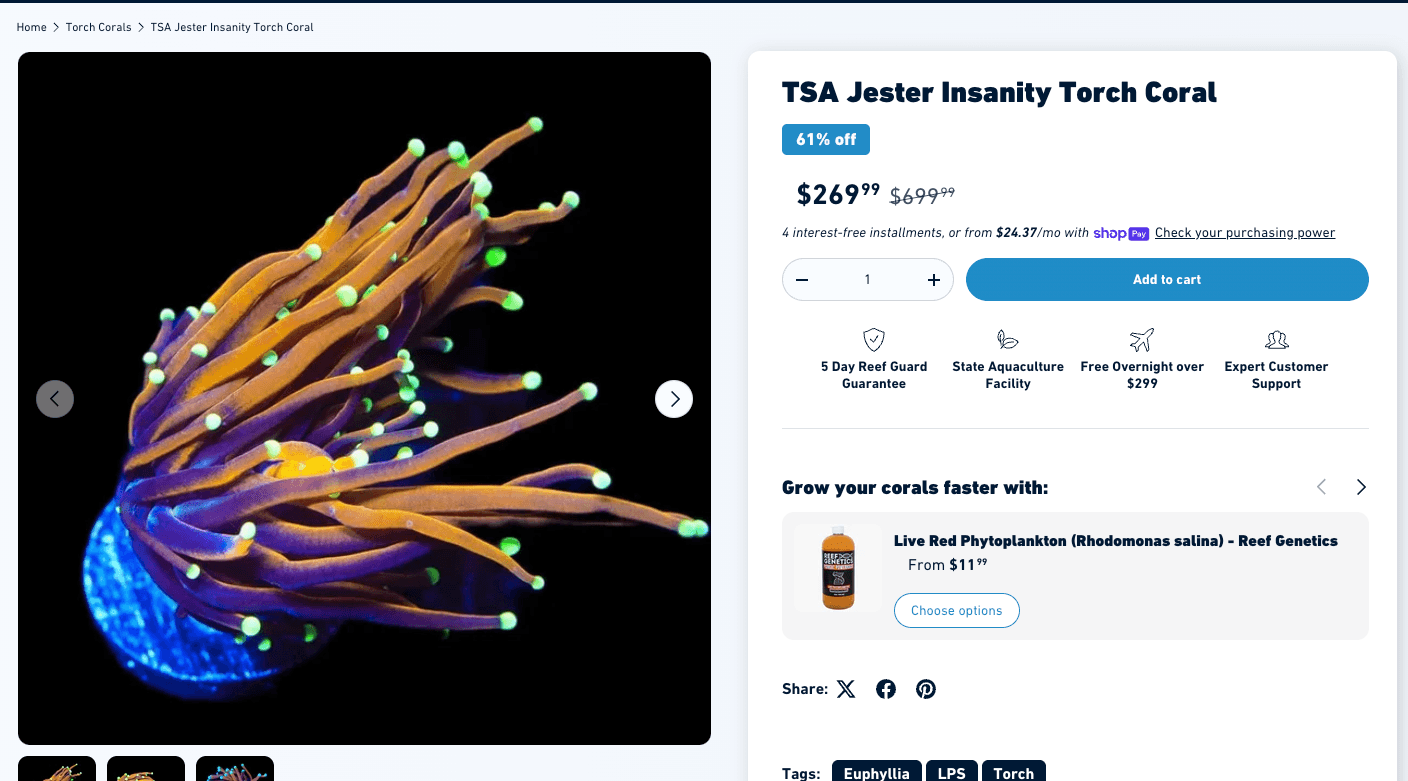
What The Visual Evidence Tells Us
The pattern revealed in these comparisons isn't merely frustrating—it's challenging the integrity of our hobby. And this is just one small example set; almost every major coral genus follows similar patterns of naming inconsistency and price variation.
To be clear, the issue isn't with premium pricing for genuinely exceptional Euphyllia specimens—some corals absolutely deserve their higher price tags. The problem lies with the inconsistent naming conventions and marketing approaches that create wildly different price points for what appear to be nearly identical corals or identical names for totally different specimens.
Take the "Sun-God Torch" priced at a "half-off" $499 (down from $1000). To experienced reefers, this looks like a standard Euphyllia cristata with gold coloration—a variety that's been common in the hobby for years and historically sold for much less. Then next to it same "Sun God" name but a completely different species of Euphyllia alltogether. This isn't innovative marketing; it's repackaging the familiar as exotic, which particularly impacts newer hobbyists who haven't yet developed the eye to recognize these patterns.
The vendor prefix phenomenon adds another layer of complexity. Adding "TSA" or "WWC" to a coral name can significantly increase the price tag without necessarily indicating proportional differences in quality, health, or genetic distinctiveness. Similarly puzzling is how the same basic coral type receives modifiers like "Baby," "Insanity," or "Ultra" that each seem to justify price increases despite not really representing or communicating physical traits.
Our CoralDB analytics provide some perspective: Euphyllia torch corals make up roughly 15% of the entire market, with gold being the MOST COMMON color variant. These aren't always rare specimens—they're increasingly available through large scale aquaculture, mariculture and wild imports. The frequency of "sale" pricing in these screenshots suggests the market is beginning to acknowledge this reality, even as the naming variations continue.
For consumers, the lesson is clear: don't buy based on names alone. Evaluate corals based on their actual appearance, health, and the reputation of the seller. Compare prices across multiple vendors and recognize when a fancy name is being used to justify a premium that may not align with the coral's inherent qualities. Without a doubt the best way to buy corals is from your local LFS, awesome garage fraggers or in person frag swaps, seeing the colors, health, size and the seller face to face, and that's coming from someone who works full time creating an online marketplace platform.
The naming game and the "renaming game" has evolved beyond helpful identification into a sophisticated marketing tool that sometimes creates price differences that don't match reality. As reef keepers, we should be able to appreciate a beautiful torch coral for what it is—not just what its marketing label suggests. After all, our hobby is about the living organisms themselves, not the fantasy names attached to them.
A Note on Vendor Challenges
It's important to acknowledge that the vast majority of coral vendors operate in good faith, balancing passion for the hobby with the realities of running a business in a competitive market. Naming distinctive corals represents a legitimate way for vendors to differentiate their offerings and receive recognition for their propagation efforts.
Truly exceptional corals often do command higher prices for valid reasons. These specimens can be genuinely difficult to aquaculture, grow slowly, require specialized care to maintain vibrant coloration, or may have taken years of selective propagation to develop. The time, expertise, and resources invested in bringing these specimens to market deserve appropriate compensation.
Often the more problematic practices typically arise not from original naming but from cases where established corals with recognized lineages are rebranded as something entirely new, with dramatically inflated prices that don't reflect actual differences. This "renaming game" creates the most confusion for hobbyists and unfairly undercuts vendors who use more transparent naming approaches.
Many vendors find themselves caught in a difficult position—either participate in naming trends to remain competitive or risk losing sales to more marketing-savvy competitors. Ethical vendors who focus on education, accurate descriptions, and reasonable pricing deserve more recognition and support from the hobby community.
As we navigate these naming challenges, acknowledging the complexity from both consumer and vendor perspectives helps us work toward a marketplace where creative naming and scientific accuracy can coexist—serving the interests of both businesses and hobbyists while advancing the hobby we all love.
The Research Rabbit Hole
The practical impact of naming inconsistency extends to the time cost imposed on hobbyists. Whether that's trying to research an acceptable price for a "Ultra Rainbow Crouching Tiger Hidden Alien Acromonti Graft" before you buy it, or a new hobbyist trying to just learn the difference between a "Paly" and a "Zoa".
I spoke with one experienced reefer who told me they purchased three Acropora Frags under three separate names - that turned out to look exactly the same as colonies, "That's $300 I could have spent on actual variety."
The Scientific Disconnect
Beyond practical confusion, the proliferation of fantasy naming has created a growing disconnect between hobby terminology and scientific understanding.
Species Misidentification and Conservation Implications
Perhaps most concerning is how trade names often obscure actual species identification which causes the hobby to miss out on valuable insights and a consistent scientifically evolved nomenclature to share knowledge and advance our hobby and husbandry of these amazing organisms.
This disconnect between hobby nomenclature and scientific classification has wider implications for conservation efforts. Our hobby already has an unfortunate divide between the scientific coral community and the reef hobby. Absurd and rapidly devolving naming conventions only widens this gap, and makes linking these two very different fields more difficult.
As one of the few hobbies that actively propagates endangered organisms, our naming practices can either support or undermine our contribution to conservation science. When we can't reliably connect our captive specimens to their wild counterparts through accurate identification, we diminish the scientific value of our propagation efforts.
In Defense of Creative Naming
Despite these challenges, there are legitimate reasons why creative naming has persisted and even flourished in the hobby.
Preservation of Lineage, Enthusiasm and Accessibility
Thoughtful naming has undeniably helped preserve important lineage information. The "Paletta Blue Acropora" and the "ORA Hawkins Echinata" aren't just marketing terms—they document propagation history for corals with unique properties that might otherwise be lost to generic identification.
There's also no denying that creative names make the hobby more engaging and accessible, often particularly for newcomers. Scientific terminology can be intimidating, while evocative names like "Space Invader Pectinia" or "Candy Apple" create immediate visual associations that help hobbyists remember and identify corals.
Rewarding Innovation
Perhaps most importantly, the current naming system rewards individuals who successfully propagate challenging species or develop distinctive color variants. The right to name a coral strain provides recognition and potential business advantage for those who advance the hobby through their propagation skills.
This incentive structure has undoubtedly contributed to the exponential growth in captive-bred coral variety available to hobbyists. Would propagators invest years in developing distinctive varieties if they couldn't distinguish their work in the marketplace and reap the benefits?
“Originally, names helped us track impressive specimens that needed to be preserved in the hobby through propagation. Today, names are often created before a coral has proven itself worthy of distinction.
A Better Way Forward
The coral naming dilemma we face isn't just an academic concern—it directly impacts our wallets, our knowledge, and ultimately the integrity of our hobby. While a single, universal naming standard might be unrealistic in such a diverse community, there are pragmatic steps we can take to bring clarity without stifling creativity.
Finding the Balance: Minimum Scientific Standards
At the very minimum, every coral listing should include genus identification—a practice that's common but not yet universal. This simple requirement creates a foundation of basic scientific literacy while still allowing ample room for creative marketing. Beyond this baseline, we should do a better job at encouraging species identification where possible, acknowledging that even marine biologists struggle with precise species designation in many coral groups.
As Michael Paletta wisely noted, not every coral deserves a flashy marketing name. The indiscriminate proliferation of fantasy names for barely distinguishable specimens has devalued the entire naming system. Perhaps the most important shift needed isn't in rules but in restraint—reserving distinctive names for truly distinctive corals.
Learning from the Best in the Business
We don't need to look outside our hobby for examples of balanced naming approaches—several leading vendors already demonstrate responsible practices. In our CoralDB analysis, Tidal Gardens consistently stands out for maintaining scientific accuracy alongside descriptive trade names. ORA, and also Cherry Corals have similarly maintained a responsible balance between marketing appeal and scientific foundation in their naming conventions.
These companies prove that scientific accuracy and commercial success aren't mutually exclusive. By highlighting and supporting businesses that maintain this balance, buyers can create market incentives for better naming practices throughout the industry.
Market Realities and Major Players
Let's be realistic about where the power lies in shaping naming conventions. Major brands like World Wide Corals and Top Shelf Aquatics, along with boutique operations like Reef Raft and Cali Kid, drive naming trends through their market influence. When these established names rebrand corals with their prefix and a randomly assigned name, they set pricing expectations and naming patterns that ripple through the hobby.
The concerning trend is how this pattern has begun moving upstream—from consumer-facing vendors up to wholesalers and importers, who traditionally used more scientific and descriptive naming. And its only a matter of time before vendors who markup prices based off bullsh*t names have their own wholesale prices marked up by bullsh*t names and of course the real loser in that game is the consumer. This shift also threatens to further disconnect our hobby from its scientific foundations as marketing names become increasingly disconnected from the corals themselves.
The Power of the Purse
The most effective force for change lies with us—the buyers. Every purchase is a vote for what we value in the hobby. By supporting sellers who maintain scientific accuracy alongside creative naming, and questioning those who rely solely on fantasy marketing, we can collectively shift the marketplace.
Platforms like Reefzoo can facilitate this change by requiring minimum standards like genus identification while using algorithms that reward more complete scientific information. However, the true catalyst for change will be informed buyers who recognize when naming crosses from useful identification into pure marketing hype.
Benefits of a More Balanced Approach
For Hobbyists
- Easier research of care requirements with consistent scientific names
- More transparent price comparisons across vendors
- Focus shifts toward successful husbandry rather than just collectibility
- Reduced risk of purchasing the same coral under different names
- More informed purchasing decisions
For the Industry
- Stronger connections to scientific and conservation communities
- More transparent business practices foster trust
- Encourages competition based on quality rather than marketing
- Greater focus on successful husbandry leads to healthier corals
- Sustainable pricing models that reward actual innovation
Your Role in Shaping the Future
As the hobby continues to grow, each of us plays a role in determining whether coral naming evolves toward greater clarity or deeper confusion. Ask questions when you encounter pure fantasy names without scientific context. Support vendors who maintain scientific accuracy alongside their creative branding. Share your knowledge with newcomers to help them navigate the naming maze.
The coral naming game has been part of our hobby for decades and will continue to be. But with more awareness and small shifts in our collective behavior, we can ensure it remains a system that genuinely helps identify and preserve remarkable corals rather than one that simply drives artificial price inflation and confusion.
The choice isn't between rigid scientific classification and creative expression—it's about finding the sweet spot where both can coexist in service to the corals we all admire.
A Better Way Forward
The journey through coral naming's evolution—from scientific precision to marketing mayhem—reveals a hobby at a crossroads. We've seen how thoughtful naming once preserved lineage and aided identification, and how that system gradually transformed into something that often confuses more than it clarifies.
The solution isn't to abandon creative naming entirely, but to recalibrate our approach. By demanding minimum scientific standards, supporting responsible vendors, and making informed purchasing decisions, we can steer the hobby back toward a naming system that serves both commerce and conservation. The choice is ours: continue down the path of ever-more-fantastical names that disconnect us from the living organisms we cherish, or chart a course that honors both the science and the passion that make this hobby extraordinary.
Join the Conversation
Join the Conversation
What's your take on coral naming conventions? Do you prefer scientific accuracy or creative trade names? Share your thoughts and experiences on the ReefZoo community forum.
Discuss on ReefZooReferences
- Lefevre, A. (2014). “Origin of the Purple Monster; Tyree L.E. and Coral Names“. Reefs.com.
- Paletta, M. (2016). “The Coral Name Game“. Reef Builders.
- Guest Author (2014). “The Trouble with Coral Trade Names“. Reef Builders.
- ReefZoo LLC (2025). “CoralDB: Tracking Price and Naming Variations“. ReefZoo.com.
- ReefBum (2023). “Jake Adams on Coral "Name Game", Rappin' With ReefBum Sound Bite“. YouTube.
- Gay, J. (2024). “The Tale of the Purple Monster and the Land of Gold“. Reef Builders.
- Adams, J. (2015). “We tracked down the Purple Monster Acro to its original source“. Reef Builders.